- 2/9/06
- 1,399
- 41
- 48
As simple as this topic sounds, a good number of newcomers to the horological world might not understand the true functions of the bezel on their very own wrists. So, here's a quick & easy summation on what those numbers mean.
There are a few different types of bezels marked for any number of things, such as calculation of distance, time, speed, etc. But the two most popular marked bezels are for calculating speed (e.g. the Rolex Daytona, the Omega Speedmaster, the Panerai 212):
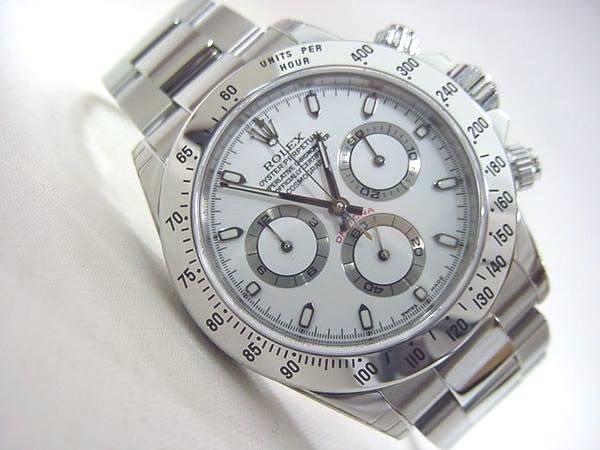
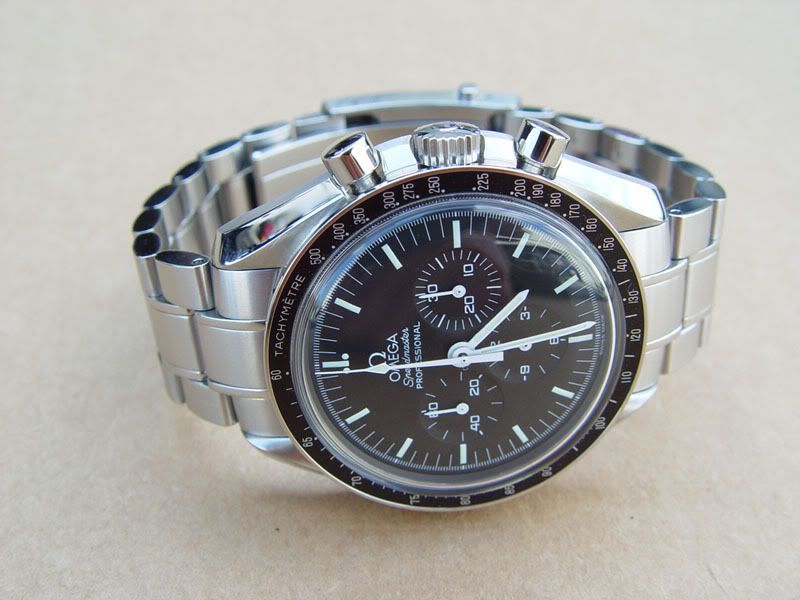
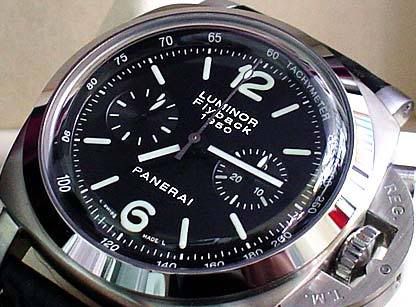
And bezels for counting down time (e.g. the Rolex Submariner, the Omega Seamaster, the IWC Aquatimer):
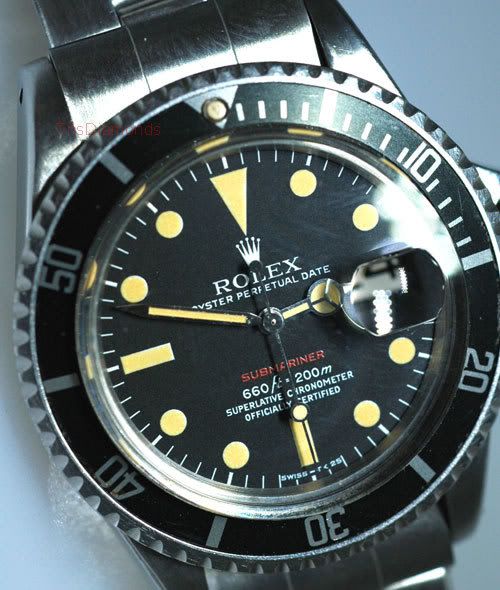
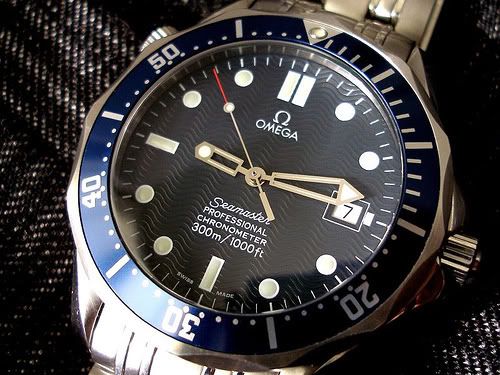
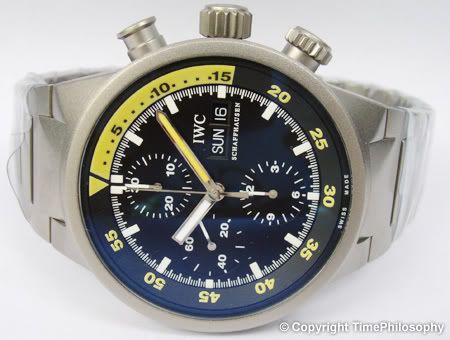
The bezel on a chronometer such as the Daytona, is essentially a speedometer, like the one on your car; it's used to clock speed, but on a distance of one mile, only. So the numbers on the bezel actually represent MPH (miles per hour). In order to be able to use the bezel as such, the watch must come with a stop-watch function, or a chronograph.
>>>>>Here's how you use the bezel in conjunction with the chronograph, to clock the speed of a moving object:
If the distance between point A & point B on a track (be it for horses or cars) is exactly 1 mile, then the second the moving object you're timing passes point A, you start the chronograph--the second the moving object passes point B, you stop the chronograph. Wherever the large second hand on the chronograph stops (on the bezel), is the exact MPH the object was traveling. In the picture below, a car clocked on the track between points A & B, appears to be traveling 160 MPH:
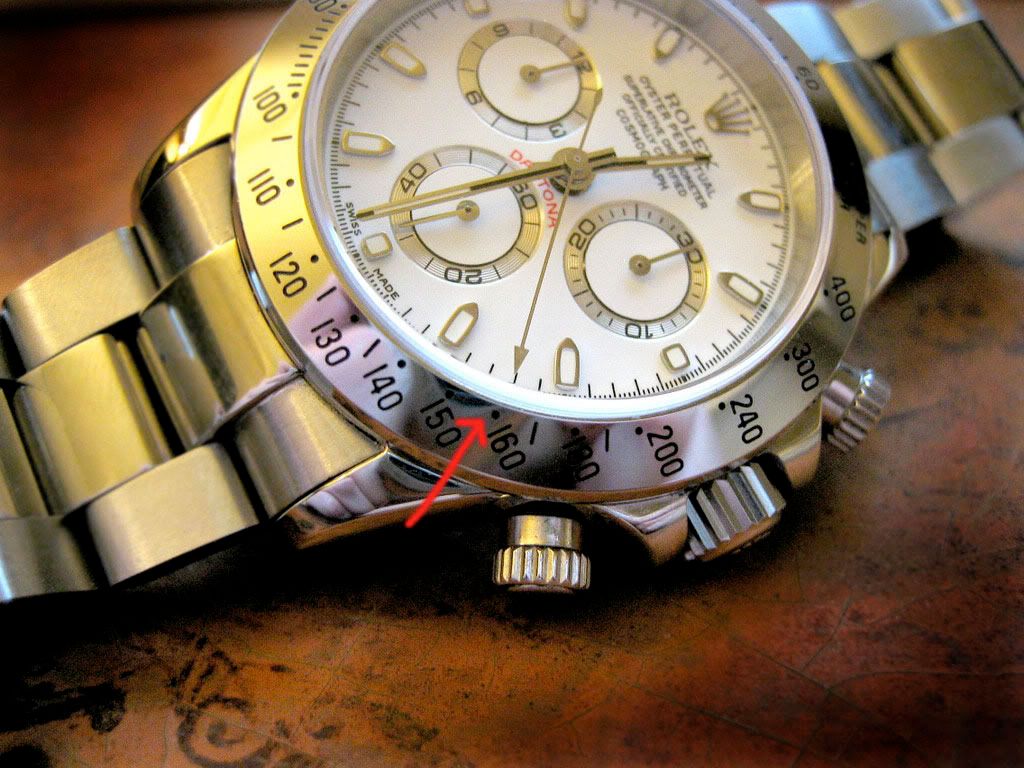
However, an exact reading only applies to an object moving at an exact speed (i.e. only going 160 MPH, no less, no more). If a car is varying in speed (i.e. it's doing 150 MPH in the turns and 170 MPH on the straight-a-way, the bezel is telling it's average speed; 160 MPH.
An easier example would be, if you're driving at 60 MPH, then you're traveling exactly 1 mile for every minute that passes. Which is why the 60 is at the top of the bezel, at the 12 o'clock position--if it took a full 60 second rotation of the chronograph hand for you to travel between points A & B--the time to travel exactly one mile--then you're going exactly 60 miles per hour. And that's how this particular bezel is used as a tachymeter, or speedometer.
This is why, as you follow the hands clockwise on a Daytona, the bezel markings go down in number; the longer it takes you to travel a distance, the slower you're traveling it.
Of course, using the bezel as a tachymeter only applies to an object traveling at a constant rate of speed. For instance, if a car was going from 0 to 60 MPH, and this took 8 seconds, if you're matching the chronograph hand to the bezel, you'll see 8 seconds reflects a speed of 400 miles an hour--this is obviously incorrect:
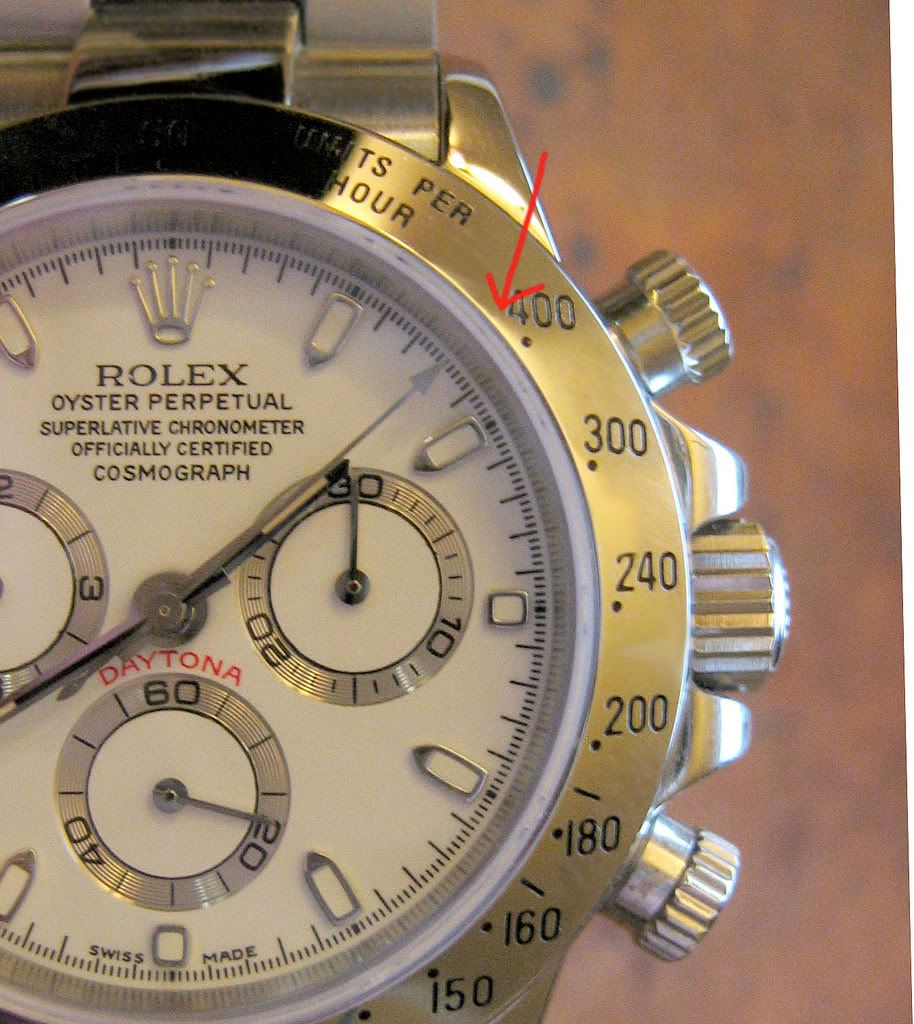
By doing this, you're calculating time and not speed (i.e. 0-60 MPH = 8 seconds, not 0-60 MPH = 400 MPH), so you should be matching the chronograph hand with the seconds markers on the dial and not the markings on the bezel.
>>>>>Here's how to use the bezel on a diver's watch as a countdown clock:
Unlike a tachymeter bezel (or tachometer, for we Americans )--which starts at 400 MPH and counts down to stop at 60 MPH at the 12 o'clock position--a diver's watch bezel is labeled 0-60 minutes (and line up exactly with the hour markers on the dial), and are labeled counting up, traveling clockwise with the watch hands, as such:
)--which starts at 400 MPH and counts down to stop at 60 MPH at the 12 o'clock position--a diver's watch bezel is labeled 0-60 minutes (and line up exactly with the hour markers on the dial), and are labeled counting up, traveling clockwise with the watch hands, as such:
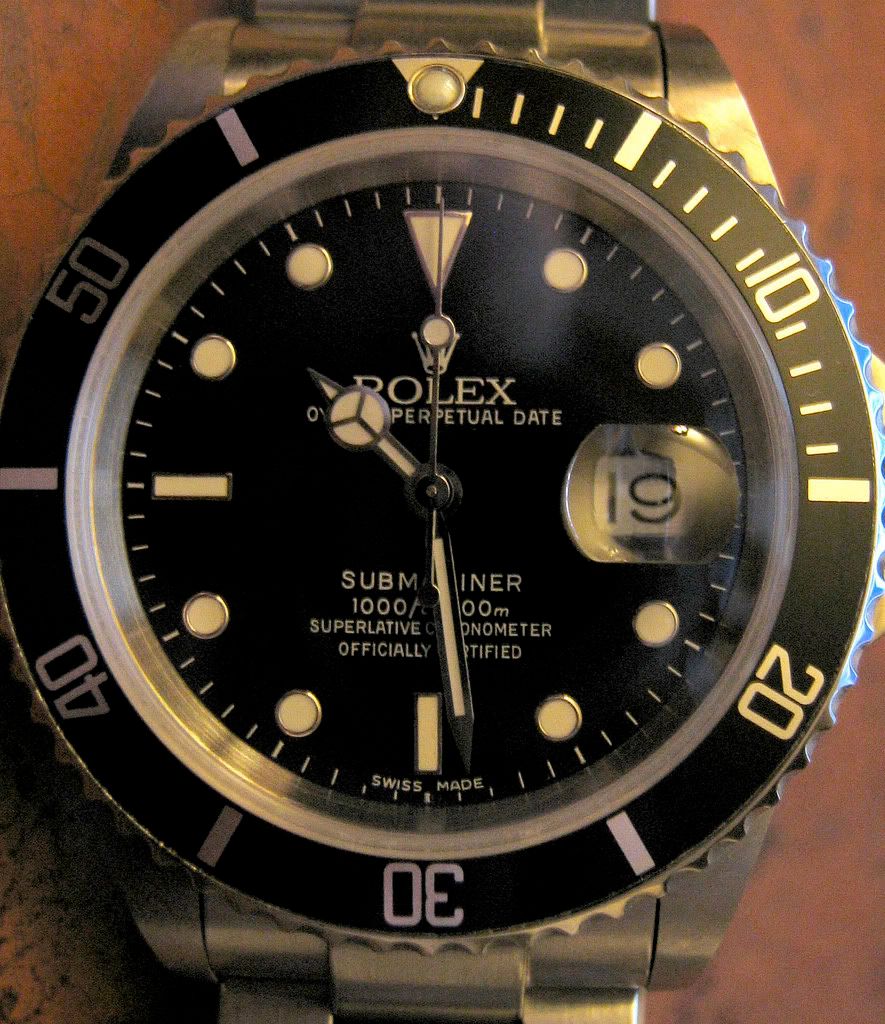
A watch without this bezel cannot be called a true "divers watch" (as it does not not comply with ISO 6425 & DIN 8306 standards for divers safety).
The first step is to align the bezel pearl (the 0 hour marker on the bezel) with the minute hand on the watch; this must be done immediately upon starting your dive (the bezel is unidirectional--it only rotates counter-clockwise, so you don't bump it when diving and accidentally move it back to a wrong position, giving you a false reading as to how much air you have left).
If you're starting your dive at 10:45, align the pearl with the minute hand at the 45 minute mark:
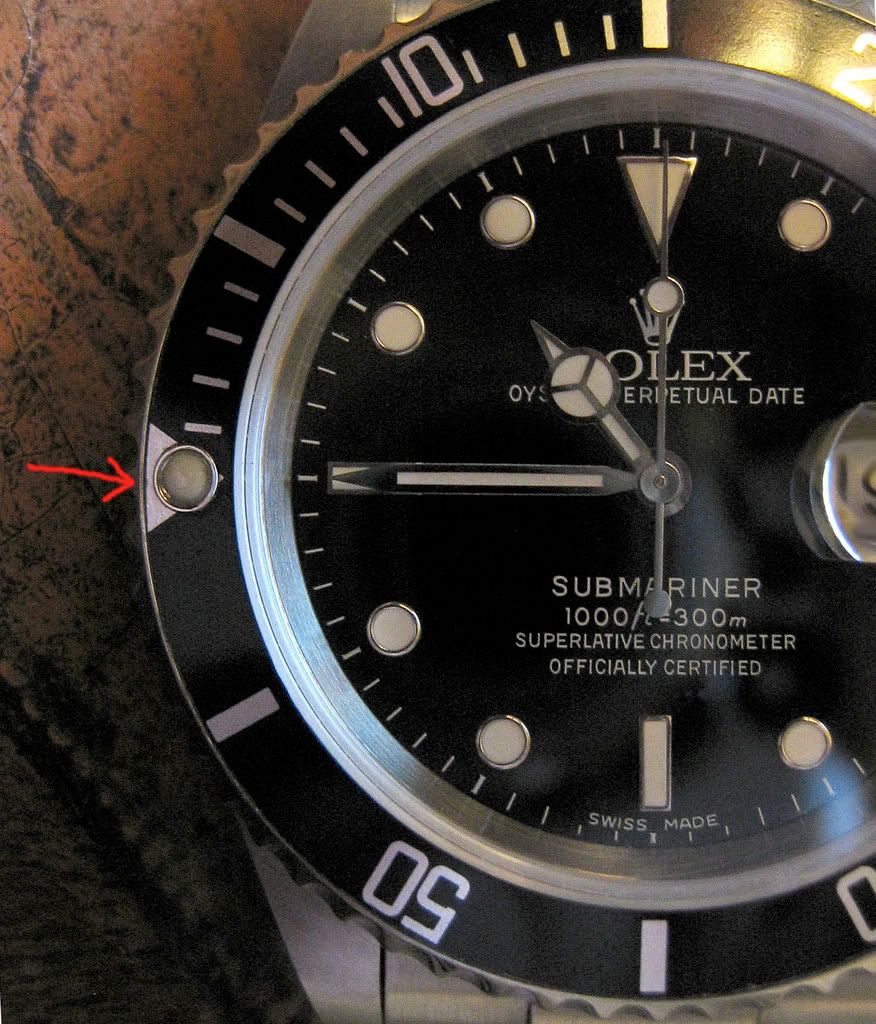
Now, in order to use it properly, you'll be coordinating the watch's minute hand in conjunction with the bezel, and not the dial. So, if you're scuba diving and know your tanks only hold 45 minutes of air, then it's time to emerge when the minute hand reaches the 45 minute mark on the bezel. 45 minutes from the start of your dive at 10:45, would be 11:30:
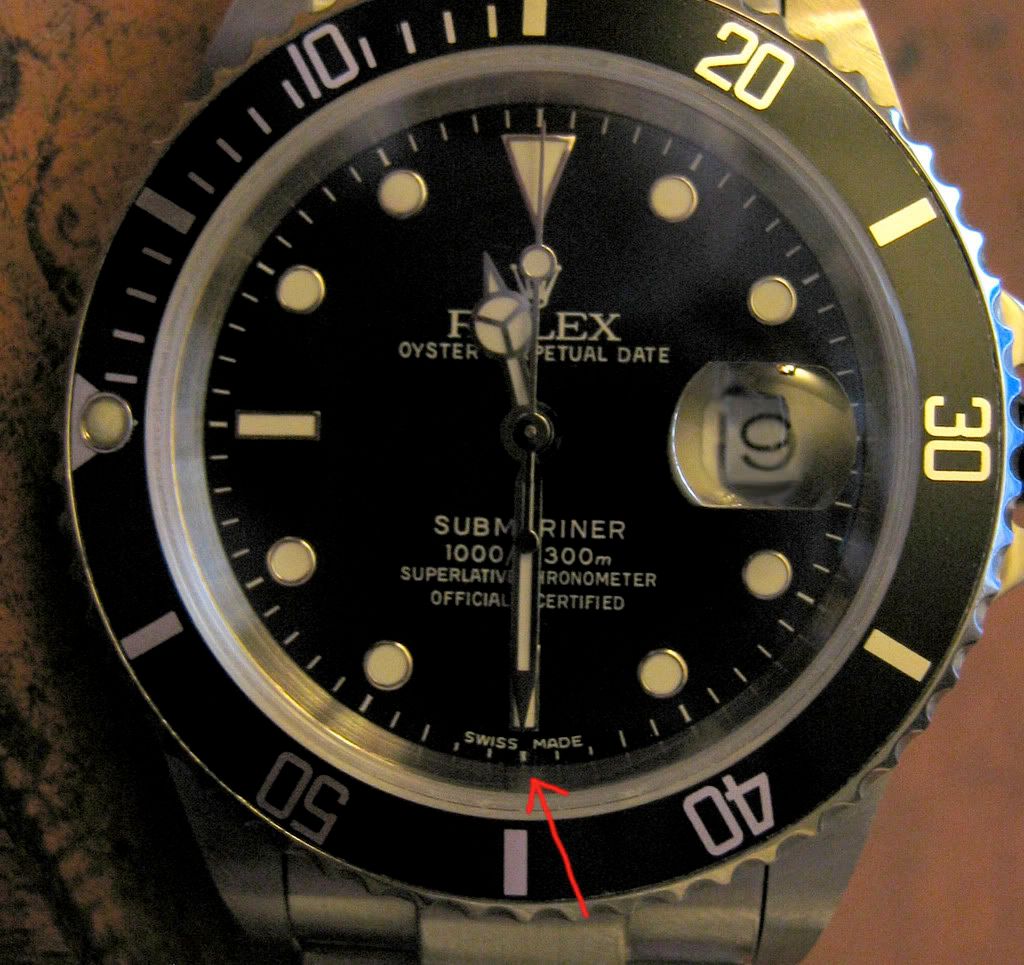
Of course, these types of diver's watches are only intended for scuba-diving, and not deep-sea or saturation diving, as most scuba dive watches such as these, can't go to those levels without an HEV (Helium Escape Valve).
Deep-sea divers must first have their bodies decompressed in a diving bell before descending to such incredible depths, and are breathing a mixture of gasses containing lowered nitrogen & oxygen, and more helium & hydrogen (because oxygen becomes toxic at high pressures, causing seizures and other problems, and nitrogen becomes poisonous in the bloodstream).
The primary reason saturation divers don't need the bezel is because they're breathing a completely different mixture of air, fed to them via tubes, and not compressed air tanks, which would implode at those depths; they dive "at saturation", meaning that because they stay for extended periods at such depths, their body tissues become saturated with nitrogen. In fact, they really have no time limit to their dive, other than that caused by the cold and local conditions. They then do their decompression inside decompression chambers, once they reach the surface. So, a timing bezel is not an absolute requirement for saturation divers. In fact, professional divers might not even be able to manipulate a timing bezel with their thick gloves.
And this is why divers watches look & function as they do, in coordination with the bezel.
Of course, sometimes you discover both on the same piece; for deep-sea dive purposes only, occasionally a watch with an HEV will combine both the chronometer/stop-watch and the diver's bezel, on models such as the Omega Seamaster Professional chronograph:

Hoped this little explanation helped, and thanks for your time.
There are a few different types of bezels marked for any number of things, such as calculation of distance, time, speed, etc. But the two most popular marked bezels are for calculating speed (e.g. the Rolex Daytona, the Omega Speedmaster, the Panerai 212):



And bezels for counting down time (e.g. the Rolex Submariner, the Omega Seamaster, the IWC Aquatimer):



The bezel on a chronometer such as the Daytona, is essentially a speedometer, like the one on your car; it's used to clock speed, but on a distance of one mile, only. So the numbers on the bezel actually represent MPH (miles per hour). In order to be able to use the bezel as such, the watch must come with a stop-watch function, or a chronograph.
>>>>>Here's how you use the bezel in conjunction with the chronograph, to clock the speed of a moving object:
If the distance between point A & point B on a track (be it for horses or cars) is exactly 1 mile, then the second the moving object you're timing passes point A, you start the chronograph--the second the moving object passes point B, you stop the chronograph. Wherever the large second hand on the chronograph stops (on the bezel), is the exact MPH the object was traveling. In the picture below, a car clocked on the track between points A & B, appears to be traveling 160 MPH:

However, an exact reading only applies to an object moving at an exact speed (i.e. only going 160 MPH, no less, no more). If a car is varying in speed (i.e. it's doing 150 MPH in the turns and 170 MPH on the straight-a-way, the bezel is telling it's average speed; 160 MPH.
An easier example would be, if you're driving at 60 MPH, then you're traveling exactly 1 mile for every minute that passes. Which is why the 60 is at the top of the bezel, at the 12 o'clock position--if it took a full 60 second rotation of the chronograph hand for you to travel between points A & B--the time to travel exactly one mile--then you're going exactly 60 miles per hour. And that's how this particular bezel is used as a tachymeter, or speedometer.
This is why, as you follow the hands clockwise on a Daytona, the bezel markings go down in number; the longer it takes you to travel a distance, the slower you're traveling it.
Of course, using the bezel as a tachymeter only applies to an object traveling at a constant rate of speed. For instance, if a car was going from 0 to 60 MPH, and this took 8 seconds, if you're matching the chronograph hand to the bezel, you'll see 8 seconds reflects a speed of 400 miles an hour--this is obviously incorrect:

By doing this, you're calculating time and not speed (i.e. 0-60 MPH = 8 seconds, not 0-60 MPH = 400 MPH), so you should be matching the chronograph hand with the seconds markers on the dial and not the markings on the bezel.
>>>>>Here's how to use the bezel on a diver's watch as a countdown clock:
Unlike a tachymeter bezel (or tachometer, for we Americans

A watch without this bezel cannot be called a true "divers watch" (as it does not not comply with ISO 6425 & DIN 8306 standards for divers safety).
The first step is to align the bezel pearl (the 0 hour marker on the bezel) with the minute hand on the watch; this must be done immediately upon starting your dive (the bezel is unidirectional--it only rotates counter-clockwise, so you don't bump it when diving and accidentally move it back to a wrong position, giving you a false reading as to how much air you have left).
If you're starting your dive at 10:45, align the pearl with the minute hand at the 45 minute mark:

Now, in order to use it properly, you'll be coordinating the watch's minute hand in conjunction with the bezel, and not the dial. So, if you're scuba diving and know your tanks only hold 45 minutes of air, then it's time to emerge when the minute hand reaches the 45 minute mark on the bezel. 45 minutes from the start of your dive at 10:45, would be 11:30:

Of course, these types of diver's watches are only intended for scuba-diving, and not deep-sea or saturation diving, as most scuba dive watches such as these, can't go to those levels without an HEV (Helium Escape Valve).
Deep-sea divers must first have their bodies decompressed in a diving bell before descending to such incredible depths, and are breathing a mixture of gasses containing lowered nitrogen & oxygen, and more helium & hydrogen (because oxygen becomes toxic at high pressures, causing seizures and other problems, and nitrogen becomes poisonous in the bloodstream).
The primary reason saturation divers don't need the bezel is because they're breathing a completely different mixture of air, fed to them via tubes, and not compressed air tanks, which would implode at those depths; they dive "at saturation", meaning that because they stay for extended periods at such depths, their body tissues become saturated with nitrogen. In fact, they really have no time limit to their dive, other than that caused by the cold and local conditions. They then do their decompression inside decompression chambers, once they reach the surface. So, a timing bezel is not an absolute requirement for saturation divers. In fact, professional divers might not even be able to manipulate a timing bezel with their thick gloves.
And this is why divers watches look & function as they do, in coordination with the bezel.
Of course, sometimes you discover both on the same piece; for deep-sea dive purposes only, occasionally a watch with an HEV will combine both the chronometer/stop-watch and the diver's bezel, on models such as the Omega Seamaster Professional chronograph:

Hoped this little explanation helped, and thanks for your time.
